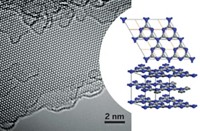Advertisement
Grab your lab coat. Let's get started
Welcome!
Welcome!
Create an account below to get 6 C&EN articles per month, receive newsletters and more - all free.
It seems this is your first time logging in online. Please enter the following information to continue.
As an ACS member you automatically get access to this site. All we need is few more details to create your reading experience.
Not you? Sign in with a different account.
Not you? Sign in with a different account.
ERROR 1
ERROR 1
ERROR 2
ERROR 2
ERROR 2
ERROR 2
ERROR 2
Password and Confirm password must match.
If you have an ACS member number, please enter it here so we can link this account to your membership. (optional)
ERROR 2
ACS values your privacy. By submitting your information, you are gaining access to C&EN and subscribing to our weekly newsletter. We use the information you provide to make your reading experience better, and we will never sell your data to third party members.
Materials
Diamond is an insulator
March 10, 2008
| A version of this story appeared in
Volume 86, Issue 10
Contrary to the assertion of Andrei P. Sommer and Dan Zhu in their letter, hydrogen-terminated diamond is indeed an insulator (C&EN, Jan. 28, page 11). This fact has been confirmed in numerous studies over many years (see, for example, Phys. Rev. Lett. 2000, 85, 3472). Sommer and Zhu observed bulk conductivity in thin films of so-called nanocrystalline diamond, a form of carbon that contains up to 10% nondiamond carbon, primarily in the grain boundaries (Appl. Phys. Lett. 2005, 86, 221914).
The nondiamond component is mainly trigonally bonded sp2 carbon, a form similar to graphite. This grain boundary material is the likely source of the bulk conductivity observed by Sommer and Zhu, not doping by hydrogen. The interested reader can find further discussions of diamond-surface conductivity in a recent Science article (2007, 318, 1424).
John C. Angus
Cleveland




Join the conversation
Contact the reporter
Submit a Letter to the Editor for publication
Engage with us on Twitter